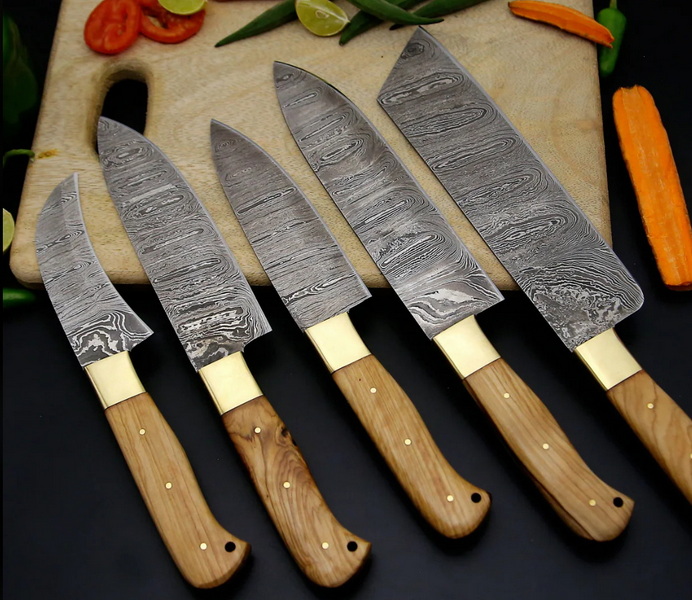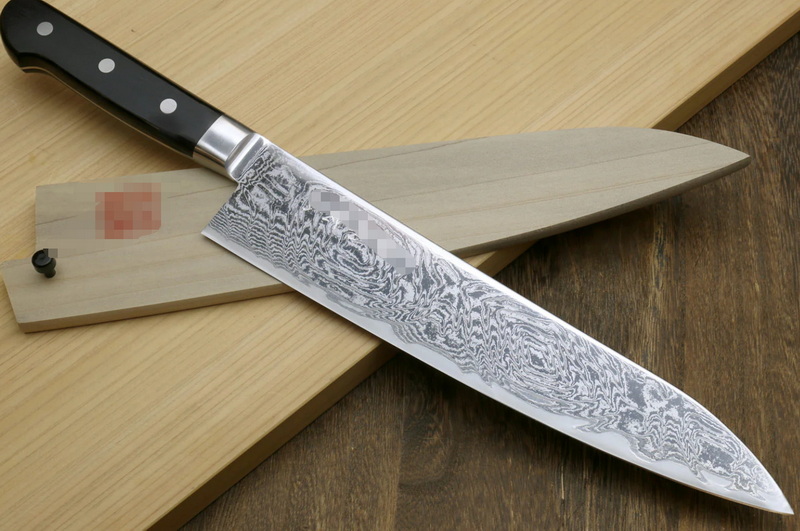- All
- Product Name
- Product Keyword
- Product Model
- Product Summary
- Product Description
- Multi Field Search
Views: 222 Author: Ann Publish Time: 2025-10-19 Origin: Site











Content Menu
● Characteristics of Damascus Knife
● Types of Damascus Knives Popular Among Beginners
>> Chef's Knife
>> Blade Material and Layer Count
>> Blade Thickness and Edge Angle
>> Brand Reputation and Warranty
● Caring for Your Damascus Knife
● Where to Buy Damascus Knives?
● Additional Tips for Beginners
● Frequently Asked Questions (FAQs)
>> 1. What makes Damascus knives different from other kitchen knives?
>> 2. How do I know if a Damascus knife is authentic?
>> 3. Can Damascus knives rust easily?
>> 4. Are Damascus knives difficult to maintain for beginners?
>> 5. Can Damascus knives be used for specialized tasks like boning?
Damascus knives have become highly sought-after by both professional chefs and home cooks for their stunning looks and exceptional cutting performance. But for beginners, choosing the right Damascus knife can be overwhelming due to the variety of styles, materials, and price ranges available. This comprehensive buying guide will help beginners understand what makes Damascus knives special, how to choose one that suits their needs, and how to care for it properly.
A Damascus knife is a type of blade forged from multiple layers of steel that are folded and welded repeatedly to create distinctive, flowing patterns on the blade surface. Though the term “Damascus” originally referred to steel produced in the Near East centuries ago, today's Damascus knives refer to blades featuring layered steel with unique pattern-welded designs.

- Layered steel blades that combine hard and soft steel types for strength and flexibility.
- Unique wavy or watery patterns that are not only beautiful but also help reduce friction while cutting.
- Typically handmade or forged with traditional techniques.
- High-performance cutting edge with excellent sharpness and edge retention.
Beginners often wonder if Damascus knives are suitable for their level of cooking skill. Here are some reasons why Damascus knives can be ideal for novice cooks:
- The sharpness and edge retention mean less effort needed to cut ingredients.
- Beautiful blade patterns encourage pride in ownership, motivating proper knife care.
- Generally balanced design and weight promote ease of handling.
- Durable thanks to hybrid steel composition.
- Many Damascus knives come with ergonomic handles designed to reduce fatigue during prolonged use.
The all-purpose chef's knife is perfect for slicing, chopping, dicing, and mincing. Most Damascus chef knives range from 6 to 10 inches in blade length. Its versatility makes it a great first knife for beginners.
Smaller than a chef's knife, utility Damascus knives are great for precision work like cutting fruits and vegetables or trimming meat. They are light and easy to handle.
The Japanese-style Santoku knife combines slicing, chopping, and dicing capabilities. Damascus Santoku knives are prized for their sharp edges, lightweight, and balance, making them suited for those who prefer precision and speed.
Though less common for beginners, Damascus boning and paring knives provide excellent control for intricate tasks such as deboning and peeling.
Selecting the right Damascus knife involves understanding key factors beyond the blade's striking appearance.
- High-quality Damascus knives typically use steels like VG10, 1095 carbon steel, or 5160 spring steel layered 33 to 67 times.
- More layers generally improve blade aesthetics and durability but can increase price.
- Ensure the core steel provides hardness (usually 58-62 HRC on the Rockwell scale) for edge retention and wear resistance.
- Avoid knives with low-quality steel or purely decorative surface patterns.
- Durable handle materials such as pakkawood, Micarta, stabilized hardwood, or synthetic composites provide comfort and grip resistance.
- The handle shape should fit your hand comfortably, allowing safe, controlled cutting without fatigue.
- Some Damascus knives feature full tang blades for better balance and strength.
- Thinner blades (around 2mm or less) allow more precise cuts but demand careful handling.
- Edge angles differ by style: Japanese-style Damascus knives often have sharper angles (around 15 degrees) than Western knives (20 degrees), affecting cutting sharpness and durability.
- Beginners should prioritize slightly thicker blades with moderate edge angles for durability.

- Beginner chefs often find 8-10 inch chef's knives most versatile.
- Consider blade weight and handle balance to ensure the knife feels natural in your hand and reduces wrist strain.
- Lighter knives offer better control, especially for detailed work.
- Damascus knives are available from budget options ($50-$100) to premium handmade knives ($200+).
- Mid-priced Damascus knives around $80-$150 strike a good balance for beginners in terms of performance and aesthetics.
- Investing in a slightly higher price point knife usually results in better materials and craftsmanship.
- Buy from trusted brands or OEM manufacturers known for quality Damascus knives.
- Look for customer reviews, material disclosures, and warranty offers.
- Some manufacturers provide lifetime sharpening services or money-back guarantees.
Proper maintenance is crucial for keeping your Damascus knife looking stunning and performing well over time.
- Always hand wash immediately after use with mild dish soap and warm water.
- Avoid using abrasive sponges or steel wool which can scratch the blade surface.
- Thoroughly dry the knife right after washing to prevent rust or water spots.
- Use whetstones (with grit progression from 1000 to 6000 or higher) to sharpen your Damascus knife for the best edge quality.
- Ceramic or diamond sharpeners can also be used but be careful not to damage layered patterns.
- Frequent honing with a honing rod preserves the cutting edge between sharpening sessions.
- Store knives in dedicated knife blocks, magnetic strips, or blade guards to protect the blade.
- Avoid tossing knives loosely in drawers where the blade can sustain damage.
- Though many Damascus knives combine stainless steel layers, early carbon steel types are susceptible to rust.
- Apply a light coating of mineral oil occasionally if you live in humid climates.
- Regular cleaning and drying are your first line of defense against corrosion.
Beyond their legendary appearance, several myths surround Damascus knives that might confuse new buyers.
- Myth: Damascus knives are too expensive for beginners.
Truth: There are reasonably priced options made with quality materials suitable for beginners.
- Myth: Damascus knives rust easily.
Truth: Properly cared-for knives with stainless Damascus layers resist rust well.
- Myth: Damascus knife patterns guarantee superior performance.
Truth: The pattern is mainly aesthetic; cutting ability depends on steel core quality and blade design.
- Myth: Damascus knives require highly specialized sharpening.
Truth: Standard sharpening tools used for other kitchen knives work well if handled properly.
- Myth: Only handmade Damascus knives are authentic.
Truth: Many reputable manufacturers use traditional forging alongside modern technologies to produce authentic Damascus blades.
- Specialist kitchenware stores and reputable online retailers.
- OEM manufacturers in China, such as those in Yangjiang, provide genuine Damascus knives with OEM customization for international clients.
- Local culinary shops may allow you to handle knives pre-purchase for personal comfort checks.
- Practice knife skills in a safe, controlled environment to get used to your Damascus knife.
- Avoid cutting bones or frozen foods with delicate Damascus blades to prevent chipping.
- Pair your Damascus knife with a good cutting board made from wood or plastic to protect the blade edge.
- Consider purchasing a knife sharpening guide or professional service alongside your knife.
A Damascus knife is an excellent investment for any kitchen, especially for beginners who want to enhance their cooking experience with a sharp, reliable, and beautifully patterned blade. Understanding the different types, materials, blade construction, and care methods will help you choose a knife that meets your needs and lasts. Whether opting for a chef's knife, Santoku, or utility knife, prioritize quality materials, balanced design, and proper maintenance. Taking these steps ensures your Damascus knife will provide years of precise cuts and striking aesthetics.

Damascus knives feature layered steel construction with unique, flowing blade patterns. This combination provides a balance of strength, flexibility, and cutting performance not common in mass-produced knives.
Authentic Damascus knives have visible layered patterns that result from forged steel layers. Purchasing from reputable manufacturers or suppliers guarantees authenticity and quality.
Knives with stainless Damascus layers resist rust well, but all knives require prompt cleaning and drying after use to prevent corrosion.
With routine cleaning, drying, and sharpening, Damascus knives are manageable for beginners and can last many years with proper care.
While exceptional at slicing and chopping, some tasks such as boning require specialized knives. Damascus boning knives are available and suitable if you want a consistent knife style.
The Ultimate Professional Knives for Halal Butchery in Middle Eastern Kitchens
Chef Knife Size Guide: Choosing Between 6″, 8″, 10″, And 12″
Custom Knife Handles: How To Design A Chef Knife That Fits Your Hand Perfectly
Chef Knife Surface Treatments Guide: From Polished Migaki To Damascus Patterns
Inside Our Professional Knife Sample Room: Quality You Can See
Universal Knife Block Buying Guide: Modern Acrylic & ABS Knife Holders for Professional Kitchens
Universal Knife Block: The Complete Guide To Modern, Hygienic Knife Storage
The Complete Guide To Red Handle Knife Sets: Style Meets Functionality in The Kitchen
Professional Knives for Halal Butchery And Middle Eastern Cuisine